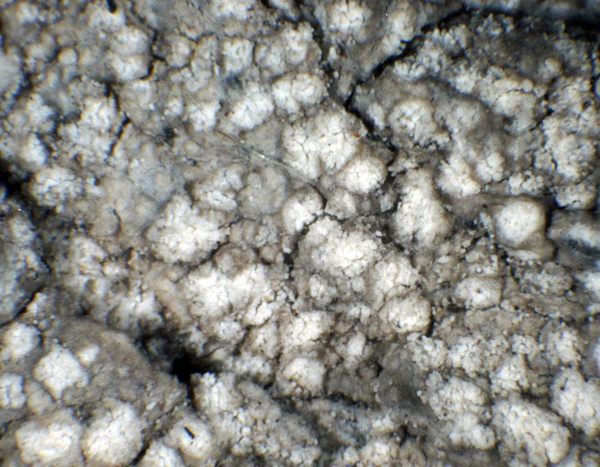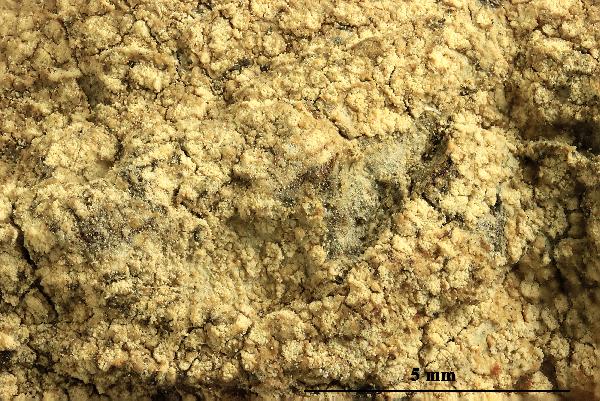Lecanora expersa Nyl.
Flora, 58: 443, 1875.
Synonyms: Lecanora elisa Nyl.; Lecanora raesaenenii Gyeln.
Distribution: N - Ven (Thor & Nascimbene 2007).
Description: Thallus crustose, whitish grey to pale greenish brown, thin, usually slightly pustulate to areolate-cracked, sometimes delimited by a black prothallus, sorediate. Soralia maculiform, rounded, whitish to yellowish white, distinctly paler than thallus, flat or concave when young, convex when old, 0.2-0.8 mm across, often delimited by a thalline rim; soredia farinose, 20-40(-50) μm thick. Apothecia rarely present, lecanorine, sessile or immersed when young, 0.3-0.6 mm across, solitary or in small clusters, sometimes confluent, with a pinkish brown to brown-black, flat to convex, often finely pruinose disc, and a flexuose, uneven, finally often excluded thalline margin. Thalline exciple with a few large crystals visible under polarized light (sometimes lacking), indistinctly corticate or with a up to 40 µm thick cortex at base; epithecium orange-brown to brown, with sparse coarse crystals dissolving in K and in N, located on the tips of paraphyses; hymenium colourless, 40-100 μm high; paraphyses branched, c. 2 µm thick ant mid-level, the apical cells only slightly swollen or to 4 µm wide; hypothecium colourless. Asci 8-spored, clavate, very thin-walled, with a K/I+ blue, tall tholus penetrated by a faintly amyloid apical cushion, the wall K/I-, surrounded by a blue outer layer, Lecanora-type. Ascospores 1-celled, hyaline, ellipsoid, 7-11 x 4-6 um. Pycnidia brown to brown-grey. Conidia filiform, straight to curved, 15-25 x 1-1.2 μm. Photobiont chlorococcoid. Spot tests: thallus K+ yellow, C-, KC-, P- or P+ slowly and faintly yellow. Chemistry: atranorin, nephrosteranic acid, sometimes roccellic acid and unidentified fatty acids.Note: on acid bark; only recently found in the Italian Alps, this lichen is probably more widespread, especially in the subalpine belt. The Italian sample was collected on a snag of Larix. It is included in the Italian red list of epiphytic lichens as “Data Deficient” (Nascimbene & al. 2013c).
Growth form: Crustose
Substrata: lignum
Photobiont: green algae other than Trentepohlia
Reproductive strategy: mainly asexual, by soredia, or soredia-like structures (e.g. blastidia)
Commonnes-rarity: (info)
Alpine belt: absent
Subalpine belt: very rare
Oromediterranean belt: absent
Montane belt: absent
Submediterranean belt: absent
Padanian area: absent
Humid submediterranean belt: absent
Humid mediterranean belt: absent
Dry mediterranean belt: absent

Predictive model
Herbarium samples
Growth form: Crustose
Substrata: lignum
Photobiont: green algae other than Trentepohlia
Reproductive strategy: mainly asexual, by soredia, or soredia-like structures (e.g. blastidia)
Commonnes-rarity: (info)
Alpine belt: absent
Subalpine belt: very rare
Oromediterranean belt: absent
Montane belt: absent
Submediterranean belt: absent
Padanian area: absent
Humid submediterranean belt: absent
Humid mediterranean belt: absent
Dry mediterranean belt: absent

Predictive model
| Herbarium samples |
 INDEX FUNGORUM
INDEX FUNGORUM
 GBIF
GBIF
 DOLICHENS
DOLICHENS






